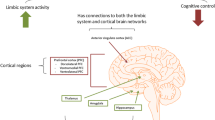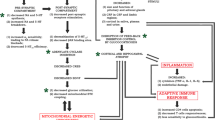Abstract
Rationale
A substantial number of patients suffering from major depressive disorder (MDD) do not respond to multiple trials of anti-depressants, develop a chronic course of disease and become treatment resistant. Most of the studies investigating molecular changes in treatment-resistant depression (TRD) have only examined a limited number of molecules and genes. Consequently, biomarkers associated with TRD are still lacking.
Objectives
This study aimed to use recently advanced high-throughput proteomic platforms to identify peripheral biomarkers of TRD defined by two staging models, the Thase and Rush staging model (TRM) and the Maudsley Staging Model (MSM).
Methods
Serum collected from an inpatient cohort of 65 individuals suffering from MDD was analysed using two different mass spectrometric-based platforms, label-free liquid chromatography mass spectrometry (LC-MSE) and selective reaction monitoring (SRM), as well as a multiplex bead based assay.
Results
In the LC-MSE analysis, proteins involved in the acute phase response and complement activation and coagulation were significantly different between the staging groups in both models. In the multiplex bead-based assay analysis TNF-α levels (log(odds) = −4.95, p = 0.045) were significantly different in the TRM comparison.
Using SRM, significant changes of three apolipoproteins A–I (β = 0.029, p = 0.035), M (β = −0.017, p = 0.009) and F (β = −0.031, p = 0.024) were associated with the TRM but not the MSM.
Conclusion
Overall, our findings suggest that proteins, which are involved in immune and complement activation, may represent potential biomarkers that could be used by clinicians to identify high-risk patients. Nevertheless, given that the molecular changes between the staging groups were subtle, the results need to be interpreted cautiously.
Similar content being viewed by others
References
Bahn S, Chan MK (2015) What can we learn about depression from gene expression in peripheral tissues? Biol Psychiatry 77:207–209. doi:10.1016/j.biopsych.2014.10.019
Baune BT, Hohoff C, Berger K et al (2008) Association of the COMT val158met variant with antidepressant treatment response in major depression. Neuropsychopharmacology 33:924–932. doi:10.1038/sj.npp.1301462
Beniger JR, Barnett V, Lewis T (1980) Outliers in statistical data. Contemp Sociol 9:560
Benjamini Y, Hochberg Y (1995) Controlling the false discovery rate: a practical and powerful approach to multiple testing. J R Stat Soc Ser B 57:289–300. doi:10.2307/2346101
Biernacka JM, Sangkuhl K, Jenkins G et al (2015) The International SSRI Pharmacogenomics Consortium (ISPC): a genome-wide association study of antidepressant treatment response. Transl Psychiatry 5, e553. doi:10.1038/tp.2015.47
Black C, Miller BJ (2015) Meta-analysis of cytokines and chemokines in suicidality: distinguishing suicidal versus nonsuicidal patients. Biol Psychiatry 78:28–37. doi:10.1016/j.biopsych.2014.10.014
Bot M, Chan MK, Jansen R et al (2015) Serum proteomic profiling of major depressive disorder. Transl Psychiatry 5, e599
Carvalho AF, Cavalcante JL, Castelo MS, Lima MCO (2007) Augmentation strategies for treatment-resistant depression: a literature review. J Clin Pharm Ther 32:415–428
Cattaneo A, Gennarelli M, Uher R et al (2013) Candidate genes expression profile associated with antidepressants response in the GENDEP study: differentiating between baseline /‘predictors’/ and longitudinal/‘targets’/. Neuropsychopharmacology 38:377–385
Chan MK, Gottschalk MG, Haenisch F et al (2014) Applications of blood-based protein biomarker strategies in the study of psychiatric disorders. Prog Neurobiol 122C:45–72. doi:10.1016/j.pneurobio.2014.08.002
Clough T, Thaminy S, Ragg S et al (2012) Statistical protein quantification and significance analysis in label-free LC-MS experiments with complex designs. BMC Bioinforma 13(Suppl 1):S6. doi:10.1186/1471-2105-13-S16-S6
Dantzer R, O’Connor JC, Freund GG et al (2008) From inflammation to sickness and depression: when the immune system subjugates the brain. Nat Rev Neurosci 9:46–56. doi:10.1038/nrn2297
Deutsche Gesellschaft für Psychiatrie P und N (DGPPN) (2015) S3-Leitlinie/Nationale Versorgungsleitlinie Unipolare Depression Langfassung. Ärztliches Zent für Qual der Medizin 1–264. doi: 10.6101/AZQ/000239
R Development Core Team (2013) R: a language and environment for statistical computing. R Found. Stat. Comput. Vienna Austria 0:{ISBN} 3–900051–07–0.
Fava M (2003) Diagnosis and definition of treatment-resistant depression. Biol Psychiatry 53:649–659. doi:10.1016/S0006-3223(03)00231-2
Fekadu A, Wooderson S, Donaldson C et al (2009) A multidimensional tool to quantify treatment resistance in depression: the Maudsley staging method. J Clin Psychiatry 70:177–184
García de Frutos P, Dahlbäck B (1994) Interaction between serum amyloid P component and C4b-binding protein associated with inhibition of factor I-mediated C4b degradation. J Immunol 152:2430–2437
Gottschalk MG, Wesseling H, Guest PC, Bahn S (2014) Proteomic enrichment analysis of psychotic and affective disorders reveals common signatures in presynaptic glutamatergic signaling and energy metabolism. Int J Neuropsychopharmacol 18:pyu019. doi:10.1093/ijnp/pyu019
Hanash SM, Pitteri SJ, Faca VM (2008) Mining the plasma proteome for cancer biomarkers. Nature 452:571–579. doi:10.1038/nature06916
Hastie TJ, Pregibon D (1992) Generalized linear models. In: Chambers JM, Hastie TJ (eds) Statistical models in S. Pacific Grove, CA, USA
Huijbers MJ, Spijker J, Donders ART et al (2012) Preventing relapse in recurrent depression using mindfulness-based cognitive therapy, antidepressant medication or the combination: trial design and protocol of the MOMENT study. BMC Psychiatry 12:1–11. doi:10.1186/1471-244X-12-125
Hummel J, Westphal S, Weber-Hamann B et al (2011) Serum lipoproteins improve after successful pharmacologic antidepressant treatment: a randomized open-label prospective trial. J Clin Psychiatry 72:885–891. doi:10.4088/JCP.09m05853blu
Iwata M, Ota KT, Duman RS (2013) The inflammasome: pathways linking psychological stress, depression, and systemic illnesses. Brain Behav Immun 31:105–114. doi:10.1016/j.bbi.2012.12.008
Jaros JAJ, Guest PC, Bahn S, Martins-de-Souza D (2013) Affinity depletion of plasma and serum for mass spectrometry-based proteome analysis. Methods Mol Biol 1002:1–11. doi:10.1007/978-1-62703-360-2_1
Kaestner F, Hettich M, Peters M et al (2005) Different activation patterns of proinflammatory cytokines in melancholic and non-melancholic major depression are associated with HPA axis activity. J Affect Disord 87:305–311. doi:10.1016/j.jad.2005.03.012
Keller MB (2003) Past, present, and future directions for defining optimal treatment outcome in depression: remission and beyond. JAMA 289:3152–3160. doi:10.1001/jama.289.23.3152\r289/23/3152 [pii]
Keller MB (2005) Issues in treatment-resistant depression. J Clin Psychiatry 66:5–12
Lange V, Picotti P, Domon B, Aebersold R (2008) Selected reaction monitoring for quantitative proteomics: a tutorial. Mol Syst Biol 4:222. doi:10.1038/msb.2008.61
Lanquillon S, Krieg JC, Bening-Abu-Shach U, Vedder H (2000) Cytokine production and treatment response in major depressive disorder. Neuropsychopharmacology 22:370–379. doi:10.1016/S0893-133X(99)00134-7
MacLean B, Tomazela DM, Shulman N et al (2010) Skyline: an open source document editor for creating and analyzing targeted proteomics experiments. Bioinformatics 26:966–968. doi:10.1093/bioinformatics/btq054
McIntyre RS, Filteau M-J, Martin L et al (2014) Treatment-resistant depression: definitions, review of the evidence, and algorithmic approach. J Affect Disord 156:1–7. doi:10.1016/j.jad.2013.10.043
Miller AH, Raison CL (2016) The role of inflammation in depression: from evolutionary imperative to modern treatment target. Nat Rev Immunol 16:22–34. doi:10.1038/nri.2015.5
NCCMH (2010) Depression: the treatment and management of depression in adults (Update).
Nemeroff CB (2007) Prevalence and management of treatment-resistant depression. J Clin Psychiatry 68:17–25
Niculescu AB, Levey D, Le-Niculescu H et al (2015) Psychiatric blood biomarkers: avoiding jumping to premature negative or positive conclusions. Mol Psychiatry 20:286–288. doi:10.1038/mp.2014.180
O’Brien SM, Scully P, Fitzgerald P et al (2007) Plasma cytokine profiles in depressed patients who fail to respond to selective serotonin reuptake inhibitor therapy. J Psychiatr Res 41:326–331. doi:10.1016/j.jpsychires.2006.05.013
Penninx BWJH, Kritchevsky SB, Yaffe K et al (2003) Inflammatory markers and depressed mood in older persons: results from the health, aging and body composition study. Biol Psychiatry 54:566–572. doi:10.1016/S0006-3223(02)01811-5
Picotti P, Aebersold R (2012) Selected reaction monitoring-based proteomics: workflows, potential, pitfalls and future directions. Nat Methods 9:555–566. doi:10.1038/nmeth.2015
Pinheiro J, Bates D, DebRoy S, et al. (2009) nlme: linear and nonlinear mixed effects models.
Powell TR, Schalkwyk LC, Heffernan AL et al (2013) Tumor necrosis factor and its targets in the inflammatory cytokine pathway are identified as putative transcriptomic biomarkers for escitalopram response. Eur Neuropsychopharmacol 23:1105–1114. doi:10.1016/j.euroneuro.2012.09.009
Raison CL, Rutherford RE, Woolwine BJ et al (2013) A randomized controlled trial of the tumor necrosis factor antagonist infliximab for treatment-resistant depression: the role of baseline inflammatory biomarkers. JAMA Psychiatry 70:31–41. doi:10.1001/2013.jamapsychiatry.4
Rapaport MH, Clary C, Fayyad R, Endicott J (2005) Quality-of-life impairment in depressive and anxiety disorders. Am J Psychiatry 162:1171–1178. doi:10.1176/appi.ajp.162.6.1171
Ruhé HG, Van Rooijen G, Spijker J et al (2012) Staging methods for treatment resistant depression. A Syst Rev J Affect Disord 137:35–45
Rush AJ, Trivedi MH, Wisniewski SR et al (2006) Acute and longer-term outcomes in depressed outpatients requiring one or several treatment steps: a STAR*D report. Am J Psychiatry 163:1905–1917. doi:10.1176/appi.ajp.163.11.1905
Sadeghi M, Roohafza H, Afshar H et al (2011) Relationship between depression and apolipoproteins A and B: a case–control study. Clinics (Sao Paulo) 66:113–117. doi:10.1590/S1807-59322011000100020
Schmidt FM, Kirkby KC, Himmerich H (2014) The TNF-alpha inhibitor etanercept as monotherapy in treatment-resistant depression—report of two cases. Psychiatr Danub 26:288–290
Schosser A, Serretti A, Souery D et al (2012) European Group for the Study of Resistant Depression (GSRD)—where have we gone so far: review of clinical and genetic findings. Eur Neuropsychopharmacol 22:453–468. doi:10.1016/j.euroneuro.2012.02.006
Schwarz G (1978) Estimating the dimension of a model. Ann Stat 6:461–464
Shao S, Guo T, Aebersold R (2015) Mass spectrometry-based proteomic quest for diabetes biomarkers. Biochim Biophys Acta 1854:519–527. doi:10.1016/j.bbapap.2014.12.012
Simon NM, McNamara K, Chow CW et al (2008) A detailed examination of cytokine abnormalities in major depressive disorder. Eur Neuropsychopharmacol 18:230–233. doi:10.1016/j.euroneuro.2007.06.004
Stelzhammer V, Haenisch F, Chan MK, et al. (2014) Proteomic changes in serum of first onset, antidepressant drug-naïve major depression patients. Int J Neuropsychopharmacol 1–10. doi: 10.1017/S1461145714000819
Strawbridge R, Arnone D, Danese A et al (2015) Inflammation and clinical response to treatment in depression: a meta-analysis. Eur Neuropsychopharmacol 25:1532–1543
Thase ME, Rush AJ (1997) When at first you don’t succeed: sequential strategies for antidepressant nonresponders. Journal of Clinical Psychiatry, In, pp 23–29
The Gene Ontology Consortium (2000) Gene ontology: tool for the unification of biology. Nat Genet 25:25–29. doi:10.1038/75556
The Gene Ontology Consortium (2015) Gene ontology consortium: going forward. Nucleic Acids Res 43:D1049–D1056. doi:10.1093/nar/gku1179
Trevino K, McClintock SM, McDonald Fischer N et al (2014) Defining treatment-resistant depression: a comprehensive review of the literature. Ann Clin Psychiatry 26:222–232
Trivedi MH, Rush AJ, Ibrahim HM et al (2004) The Inventory of Depressive Symptomatology, Clinician Rating (IDS-C) and Self-Report (IDS-SR), and the Quick Inventory of Depressive Symptomatology, Clinician Rating (QIDS-C) and Self-Report (QIDS-SR) in public sector patients with mood disorders: a psych. Psychol Med 34:73–82
Warner-Schmidt JL, Vanover KE, Chen EY et al (2011) Antidepressant effects of selective serotonin reuptake inhibitors (SSRIs) are attenuated by antiinflammatory drugs in mice and humans. Proc Natl Acad Sci U S A 108:9262–9267. doi:10.1073/pnas.1104836108
Acknowledgments
This study was supported by EU-FP7-HEALTH-F2-2008-222963 “MOODINFLAME” and by EU-FP7-PEOPLE-2009-IAPP “PSYCH-AID”. These supporters had no further role in study design; in the collection, analysis and interpretation of data; in the writing of the report and in the decision to submit the paper for publication.
Drs. Chan, Cooper and Prof. Bahn were also supported by grants from the Stanley Medical Research Institute (no. 07R-1888) and the EU-FP7 SchizDX.
Author contributions
TR and MKC designed the study and are responsible for the statistical analyses and the first draft of the manuscript. VA, MR, LS and TR were responsible for recruitment and clinical characterization of the patients; TR and PS performed the laboratory work. JC supervised the statistical analyses. VA and SB supervised the study and were involved in the design of the study. All authors contributed to and have approved the final manuscript.
Author information
Authors and Affiliations
Corresponding author
Ethics declarations
Conflict of interest
Prof. Bahn is a director of Psynova Neurotech Ltd. Dr. Cooper is a consultant for Psynova Neurotech Ltd. No other authors report potential conflict of interest.
Additional information
Tillmann Ruland and Man K. Chan contributed equally to this work.
Electronic supplementary material
Below is the link to the electronic supplementary material.
ESM 1
(PDF 199 kb)
Rights and permissions
About this article
Cite this article
Ruland, T., Chan, M.K., Stocki, P. et al. Molecular serum signature of treatment resistant depression. Psychopharmacology 233, 3051–3059 (2016). https://doi.org/10.1007/s00213-016-4348-0
Received:
Accepted:
Published:
Issue Date:
DOI: https://doi.org/10.1007/s00213-016-4348-0




